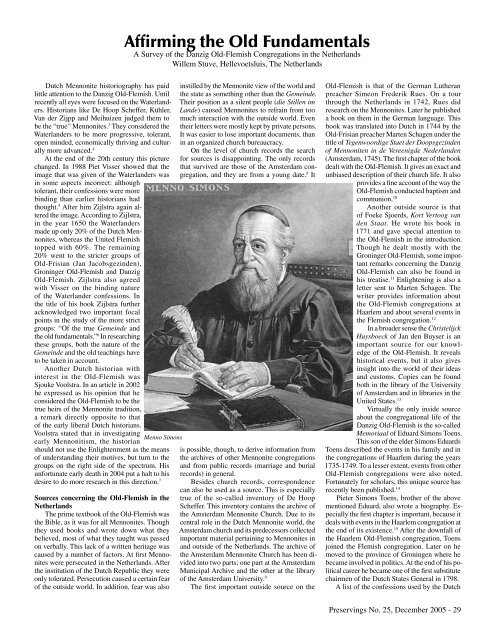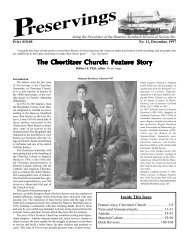Preservings $20 No. 25, December, 2005 - Plett Foundation
Preservings $20 No. 25, December, 2005 - Plett Foundation
Preservings $20 No. 25, December, 2005 - Plett Foundation
Create successful ePaper yourself
Turn your PDF publications into a flip-book with our unique Google optimized e-Paper software.
Dutch Mennonite historiography has paid<br />
little attention to the Danzig Old-Flemish. Until<br />
recently all eyes were focused on the Waterlanders.<br />
Historians like De Hoop Scheffer, Kühler,<br />
Van der Zijpp and Meihuizen judged them to<br />
be the “true” Mennonites. 3 They considered the<br />
Waterlanders to be more progressive, tolerant,<br />
open minded, economically thriving and culturally<br />
more advanced. 4<br />
At the end of the 20th century this picture<br />
changed. In 1988 Piet Visser showed that the<br />
image that was given of the Waterlanders was<br />
in some aspects incorrect: although<br />
tolerant, their confessions were more<br />
binding than earlier historians had<br />
thought. 5 After him Zijlstra again altered<br />
the image. According to Zijlstra,<br />
in the year 1650 the Waterlanders<br />
made up only 20% of the Dutch Mennonites,<br />
whereas the United Flemish<br />
topped with 60%. The remaining<br />
20% went to the stricter groups of<br />
Old-Frisian (Jan Jacobsgezinden),<br />
Groninger Old-Flemish and Danzig<br />
Old-Flemish. Zijlstra also agreed<br />
with Visser on the binding nature<br />
of the Waterlander confessions. In<br />
the title of his book Zijlstra further<br />
acknowledged two important focal<br />
points in the study of the more strict<br />
groups: “Of the true Gemeinde and<br />
the old fundamentals.” 6 In researching<br />
these groups, both the nature of the<br />
Gemeinde and the old teachings have<br />
to be taken in account.<br />
Another Dutch historian with<br />
interest in the Old-Flemish was<br />
Sjouke Voolstra. In an article in 2002<br />
he expressed as his opinion that he<br />
considered the Old-Flemish to be the<br />
true heirs of the Mennonite tradition,<br />
a remark directly opposite to that<br />
of the early liberal Dutch historians.<br />
Voolstra stated that in investigating<br />
early Mennonitism, the historian<br />
should not use the Enlightenment as the means<br />
of understanding their motives, but turn to the<br />
groups on the right side of the spectrum. His<br />
unfortunate early death in 2004 put a halt to his<br />
desire to do more research in this direction. 7<br />
Affirming the Old Fundamentals<br />
A Survey of the Danzig Old-Flemish Congregations in the Netherlands<br />
Willem Stuve, Hellevoetsluis, The Netherlands<br />
Menno Simons<br />
Sources concerning the Old-Flemish in the<br />
Netherlands<br />
The prime textbook of the Old-Flemish was<br />
the Bible, as it was for all Mennonites. Though<br />
they used books and wrote down what they<br />
believed, most of what they taught was passed<br />
on verbally. This lack of a written heritage was<br />
caused by a number of factors. At first Mennonites<br />
were persecuted in the Netherlands. After<br />
the institution of the Dutch Republic they were<br />
only tolerated. Persecution caused a certain fear<br />
of the outside world. In addition, fear was also<br />
instilled by the Mennonite view of the world and<br />
the state as something other than the Gemeinde.<br />
Their position as a silent people (die Stillen im<br />
Lande) caused Mennonites to refrain from too<br />
much interaction with the outside world. Even<br />
their letters were mostly kept by private persons.<br />
It was easier to lose important documents, than<br />
in an organized church bureaucracy.<br />
On the level of church records the search<br />
for sources is disappointing. The only records<br />
that survived are those of the Amsterdam congregation,<br />
and they are from a young date. 8 It<br />
is possible, though, to derive information from<br />
the archives of other Mennonite congregations<br />
and from public records (marriage and burial<br />
records) in general.<br />
Besides church records, correspondence<br />
can also be used as a source. This is especially<br />
true of the so-called inventory of De Hoop<br />
Scheffer. This inventory contains the archive of<br />
the Amsterdam Mennonite Church. Due to its<br />
central role in the Dutch Mennonite world, the<br />
Amsterdam church and its predecessors collected<br />
important material pertaining to Mennonites in<br />
and outside of the Netherlands. The archive of<br />
the Amsterdam Mennonite Church has been divided<br />
into two parts; one part at the Amsterdam<br />
Municipal Archive and the other at the library<br />
of the Amsterdam University. 9<br />
The first important outside source on the<br />
Old-Flemish is that of the German Lutheran<br />
preacher Simeon Frederik Rues. On a tour<br />
through the Netherlands in 1742, Rues did<br />
research on the Mennonites. Later he published<br />
a book on them in the German language. This<br />
book was translated into Dutch in 1744 by the<br />
Old-Frisian preacher Marten Schagen under the<br />
title of Tegenwoordige Staet der Doopsgezinden<br />
of Mennoniten in de Vereenigde Nederlanden<br />
(Amsterdam, 1745). The first chapter of the book<br />
dealt with the Old-Flemish. It gives an exact and<br />
unbiased description of their church life. It also<br />
provides a fine account of the way the<br />
Old-Flemish conducted baptism and<br />
communion. 10<br />
Another outside source is that<br />
of Foeke Sjoerds, Kort Vertoog van<br />
den Staat. He wrote his book in<br />
1771 and gave special attention to<br />
the Old-Flemish in the introduction.<br />
Though he dealt mostly with the<br />
Groninger Old-Flemish, some important<br />
remarks concerning the Danzig<br />
Old-Flemish can also be found in<br />
his treatise. 11 Enlightening is also a<br />
letter sent to Marten Schagen. The<br />
writer provides information about<br />
the Old-Flemish congregations at<br />
Haarlem and about several events in<br />
the Flemish congregation. 12<br />
In a broader sense the Christelijck<br />
Huysboeck of Jan den Buyser is an<br />
important source for our knowledge<br />
of the Old-Flemish. It reveals<br />
historical events, but it also gives<br />
insight into the world of their ideas<br />
and customs. Copies can be found<br />
both in the library of the University<br />
of Amsterdam and in libraries in the<br />
United States. 13<br />
Virtually the only inside source<br />
about the congregational life of the<br />
Danzig Old-Flemish is the so-called<br />
Memoriaal of Eduard Simons Toens.<br />
This son of the elder Simons Eduards<br />
Toens described the events in his family and in<br />
the congregations of Haarlem during the years<br />
1735-1749. To a lesser extent, events from other<br />
Old-Flemish congregations were also noted.<br />
Fortunately for scholars, this unique source has<br />
recently been published. 14<br />
Pieter Simons Toens, brother of the above<br />
mentioned Eduard, also wrote a biography. Especially<br />
the first chapter is important, because it<br />
deals with events in the Haarlem congregation at<br />
the end of its existence. 15 After the downfall of<br />
the Haarlem Old-Flemish congregation, Toens<br />
joined the Flemish congregation. Later on he<br />
moved to the province of Groningen where he<br />
became involved in politics. At the end of his political<br />
career he became one of the first substitute<br />
chairmen of the Dutch States General in 1798.<br />
A list of the confessions used by the Dutch<br />
<strong>Preservings</strong> <strong>No</strong>. <strong>25</strong>, <strong>December</strong> <strong>2005</strong> - 29

















